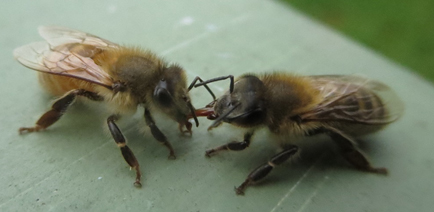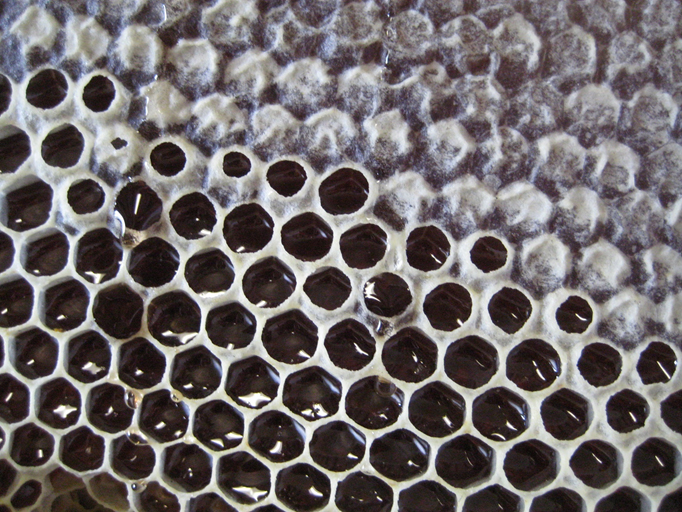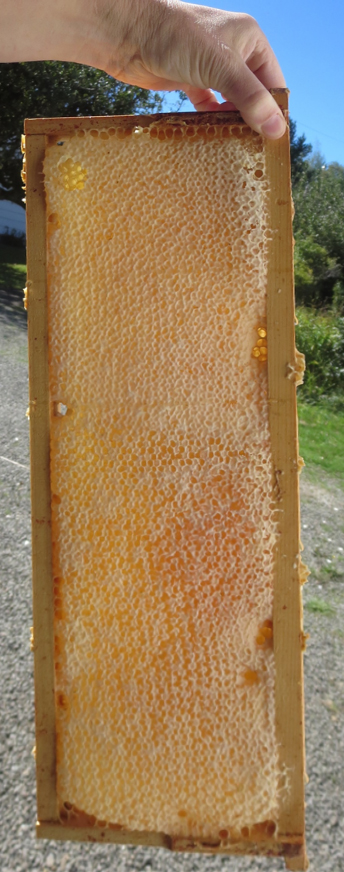Honey is a precious resource, produced by the labor of hundreds of thousands of worker bees.
 It starts out as nectar, produced by flowers. Honey bees collect this nectar in a special compartment in their digestive tract called the “honey stomach.” While in the honey stomach, the nectar is subject to digestive enzymes which begin to break down the larger sugar molecules (sucrose) into glucose and fructose.
It starts out as nectar, produced by flowers. Honey bees collect this nectar in a special compartment in their digestive tract called the “honey stomach.” While in the honey stomach, the nectar is subject to digestive enzymes which begin to break down the larger sugar molecules (sucrose) into glucose and fructose.
 A honey bee can collect up to about 75 milligrams of nectar in her honey stomach, but averages more around 30, before returning to the colony to “unload.” She regurgitates the contents of her honey stomach into the mouth of a “house bee,” who further refines the nectar by repeated regurgitation and consumption.
A honey bee can collect up to about 75 milligrams of nectar in her honey stomach, but averages more around 30, before returning to the colony to “unload.” She regurgitates the contents of her honey stomach into the mouth of a “house bee,” who further refines the nectar by repeated regurgitation and consumption.
 After the house bee has spent 20-30 minutes digesting the nectar, effectively breaking down all the complex sugars into simple sugars, she places it in wax cells (honeycomb) for drying. Evaporation is assisted by the flapping of her wings, which keeps air circulating over the surface. Once the cells are filled, and the moisture content is below 18%, the bees cover the cell with a layer of wax. This step is important as honey is hygroscopic – it will pull moisture from the surrounding air. (This effect is why honey is so useful on wounds, and why it stays free of bacteria – it pulls the moisture out of the critters and they die.)
After the house bee has spent 20-30 minutes digesting the nectar, effectively breaking down all the complex sugars into simple sugars, she places it in wax cells (honeycomb) for drying. Evaporation is assisted by the flapping of her wings, which keeps air circulating over the surface. Once the cells are filled, and the moisture content is below 18%, the bees cover the cell with a layer of wax. This step is important as honey is hygroscopic – it will pull moisture from the surrounding air. (This effect is why honey is so useful on wounds, and why it stays free of bacteria – it pulls the moisture out of the critters and they die.)
Meanwhile, the forager returns to the field to gather more nectar. She may average about ten trips in a day. A worker bee who has reached foraging age lasts an average of 10 days afield. Lucky, long-lived foragers may spend up to 20 days afield. In either case, it is the final job held by worker bees.
 In her entire lifetime, a single worker may gather about 3 grams of nectar. That’s the weight of a penny. Three grams of nectar processes down to about .75 grams of honey. And this is where I explain why honey is such a precious resource: If we were to pay the true price of honey, most of us would not be able to afford it.
In her entire lifetime, a single worker may gather about 3 grams of nectar. That’s the weight of a penny. Three grams of nectar processes down to about .75 grams of honey. And this is where I explain why honey is such a precious resource: If we were to pay the true price of honey, most of us would not be able to afford it.
Honey bees can forage over five miles from their colony, but in general stay within about a mile of home. Let’s average each of her trips to ¾ mile, and assume she’s bringing in about 35 milligrams per trip, and that she’s making 10 trips per day over ten days. That’s 75 miles and 3,500mg (or 3.5 grams) of nectar per bee. Three and a half grams of nectar converts to about .87 grams of honey per bee, or .03 ounces.
 SO, an ounce of honey is equivalent to the life’s work of about 33 honeybees. 33 x 75 miles = 2,475 miles flown to create one ounce of nectar. Today’s rate for mileage is $.54/mile. If we were to pay just mileage on every ounce of honey, it would cost us $1,337/ounce or $21,384 per pound.
SO, an ounce of honey is equivalent to the life’s work of about 33 honeybees. 33 x 75 miles = 2,475 miles flown to create one ounce of nectar. Today’s rate for mileage is $.54/mile. If we were to pay just mileage on every ounce of honey, it would cost us $1,337/ounce or $21,384 per pound.
Let’s look at what a forager’s wages would be. Minimum wage in Washington is currently $9.47/hour. Some estimates state that a foraging trip for a worker bee gathering nectar is about 20 minutes. If she makes ten trips for nectar each day, over ten days, that’s about 33 hours total, or $313. The total wages due for each ounce of honey would be $10,329. And that doesn’t take into account the work done inside the colony to process the nectar into honey.
A full super frame, one of nine or ten in each super, holds about 7 pounds, or 112 ounces, of honey – the life’s work of over 4,000 bees. Considering all the hours of labor and lives devoted to making it, honey truly is a precious resource!
In Honey Primer – Part 2 we’ll look at the qualities and behavior of different varieties of honey.